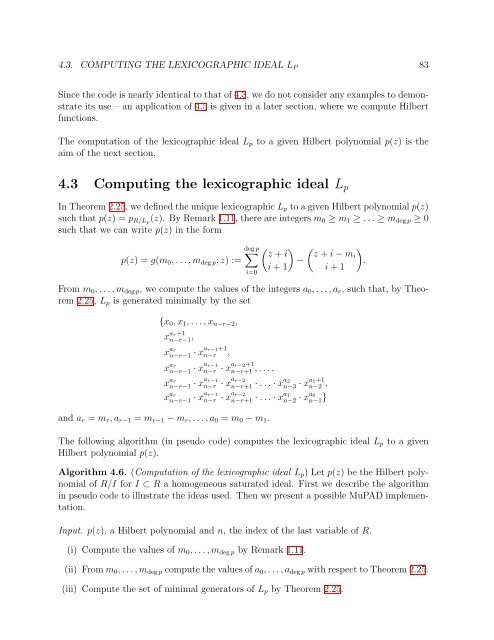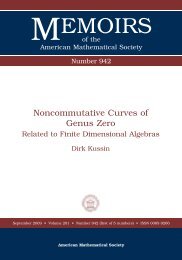University of Paderborn Department of Mathematics Diploma Thesis ...
University of Paderborn Department of Mathematics Diploma Thesis ...
University of Paderborn Department of Mathematics Diploma Thesis ...
Create successful ePaper yourself
Turn your PDF publications into a flip-book with our unique Google optimized e-Paper software.
4.3. COMPUTING THE LEXICOGRAPHIC IDEAL L P 83Since the code is nearly identical to that <strong>of</strong> 4.3, we do not consider any examples to demonstrateits use – an application <strong>of</strong> 4.5 is given in a later section, where we compute Hilbertfunctions.The computation <strong>of</strong> the lexicographic ideal L p to a given Hilbert polynomial p(z) is theaim <strong>of</strong> the next section.4.3 Computing the lexicographic ideal L pIn Theorem 2.25, we defined the unique lexicographic L p to a given Hilbert polynomial p(z)such that p(z) = p R/Lp (z). By Remark 1.11, there are integers m 0 ≥ m 1 ≥ . . . ≥ m deg p ≥ 0such that we can write p(z) in the formp(z) = g(m 0 , . . . , m deg p ; z) :=deg p∑i=0( ) z + i−i + 1( z + i − mii + 1From m 0 , . . . , m deg p , we compute the values <strong>of</strong> the integers a 0 , . . . , a r , such that, by Theorem2.25, L p is generated minimally by the set{x 0 , x 1 , . . . , x n−r−2 ,x ar+1n−r−1,x arn−r−1 · x a r−1+1n−r ,x arn−r−1 · x a r−1n−r · x a r−2+1n−r+1 , . . . ,x arn−r−1 · x a r−1n−r · x a r−2n−r+1 · . . . · x a 2n−3 · x a 1+1n−2 ,x arn−r−1 · x a r−1n−r · x a r−2n−r+1 · . . . · x a 1n−2 · x a 0n−1}and a r = m r , a r−1 = m r−1 − m r , . . . , a 0 = m 0 − m 1 .The following algorithm (in pseudo code) computes the lexicographic ideal L p to a givenHilbert polynomial p(z).Algorithm 4.6. (Computation <strong>of</strong> the lexicographic ideal L p ) Let p(z) be the Hilbert polynomial<strong>of</strong> R/I for I ⊂ R a homogeneous saturated ideal. First we describe the algorithmin pseudo code to illustrate the ideas used. Then we present a possible MuPAD implementation.Input. p(z), a Hilbert polynomial and n, the index <strong>of</strong> the last variable <strong>of</strong> R.(i) Compute the values <strong>of</strong> m 0 , . . . , m deg p by Remark 1.11.(ii) From m 0 , . . . , m deg p compute the values <strong>of</strong> a 0 , . . . , a deg p with respect to Theorem 2.25.(iii) Compute the set <strong>of</strong> minimal generators <strong>of</strong> L p by Theorem 2.25.).
















